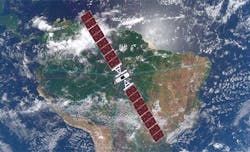Space Broadband Wars Heat Up: SES Connects Azure Cloud, Cruise Ships
In a world full of SpaceX Starlink buzz, satellite operator SES is asserting its future in space broadband, touting its existing edge computing customers and ties with Microsoft Azure, along with the use of its newest satellites to provide addition network diversity, service resilience, and gigabit connectivity.
The company held a virtual press preview this week of its next-generation O3b mPOWER satellites scheduled to be launched later this year, labeling its O3b medium Earth orbit (MEO) network as a “goldilocks” broadband satellite solution when compared to existing geosynchronous Earth orbit (GEO) and low Earth orbit (LEO) constellations being built by SpaceX, OneWeb, and Telesat. GEO satellites have half-second or longer delays due to their distance from Earth, while LEO constellations are more complex to launch and manage in orbit, say SES executives.
When fully operational next year, O3b mPOWER will deliver what a SES press release calls “an unprecedented increase of flexibility and throughput speed and capacity to any Azure Network locations on earth.” Microsoft is tapping into O3b today to showcase its Azure Orbital solutions integrating satellite connectivity with Azure cloud services.
“Utilizing SES’ medium earth orbit system enhances the power of Azure Orbital and enables us to deliver greater resiliency and comprehensive satellite connectivity solutions for our customers,” said William Chappell, Vice President of Azure Global at Microsoft. “Our collaboration with SES is key to delivering on our vision of multi-orbit, cloud-enabled capability to meet critical industry needs.”
A ‘Dramatic Leap in Capability’
Today’s announcements are the latest in a series of steps Microsoft and SES have taken to work together. Last year, Microsoft announced it would connect its data centers to satellite data networks including hosting four SES ground stations next to Azure data centers and using SES as a satellite broadband provider to connect Azure Modular Data Centers to the larger Azure cloud.
SES currently operates a fleet of 20 first-generation O3b satellites launched between 2013 and 2019, flying at an altitude of around 8,000 kilometers above the earth. At that altitude, the satellites provide an end-to-end round-trip latency of around 140 milliseconds (ms) for data services with each capable of delivering 10 user beams of capacity using mechanically steerable antennas with a capacity of up to 10 Gbps per beam.
The eleven new O3b mPOWER satellites being built by Boeing will deliver a dramatic leap in capability that Boeing Senior Vice President Jim Chilton described as a “leap from an old cathode ray tube television to a new flat panel, probably five generations in one leap.” The new hardware includes flat-panel antenna arrays enabling up to 5,000 spot beams – 5,000 different areas – can be served by a single satellite.
O3b satellite broadband capacity along with SES GEO satellite capacity can be directed virtually in software via Open Network Automation Platform (ONAP) using NFV (network functions virtualization) on Azure, so allocating and redirecting bandwidth is done easily in the cloud to manage and allocate resources.
Connecting Cruise Experiences
SES says the new technology can provide more satisfying broadband services in challenging environments like cruise ships and airplanes.
“We go from serving the top 50 cruise ships on the planet to every single cruise ship on the planet,” said SES CEO Steve Collar, citing one example where O3b mPower provides additional capacity and capabilities provided additional benefits. The new satellites will provide expanded ability to deliver services across Latin America and other regions of the world and surge capacity to address the needs of international travelers.
“If you think about cruise (lines), if you go to Miami, all the cruise ships come into port at the same time and they all leave at the same time,” Collar said. “The same thing happens (in aviation), the planes all take off from Europe at the same time, they all land in the U.S. at the same time … so you get this high concentration of demand. We’re able to move power and bandwidth across the system flexibly and dynamically in order to deliver those kinds of services.”
Carnival Cruise Lines, an early customer of O3b, is leveraging satellite connectivity to directly connect its fleet of ships seamlessly and in real time to shore-based/cloud-based resources, providing more than just onboard Wi-Fi for its Medallion experience. The OceanMedallion disk provided to Princess Cruises passengers is an IoT token enabling them to check in at the terminal for expedited boarding, serve as a room key onboard, ordering and paying for food and drink anywhere on the ship, as well as keeps track of passengers to see if they are out of their cabin.
“Connectivity is beyond fundamental,” said John Padgett, Chief Experience and Innovation Officer at Carnival Corporation. “What we’re talking about here is the world’s first truly smart cities. You know, everyone likes to claim smart buildings and smart cities, but at the end of the day a cruise ship is a self-contained city.”
Padgett views O3b mPOWER as a true enabler for Carnival with passengers able to access every service from basic safety and health to casinos and spas onboard. “With O3b mPOWER we’re going to cost efficiently move two gigabytes of service to a cruise ship,” he said. “There’s literally millions and millions of data points a day that we’re running in our global operations with a mobile platform like a cruise ship… When you think about transforming your business operation driven by intelligence, you can’t do that with lagging information, it has to be in the real [time.]”
About the Author



